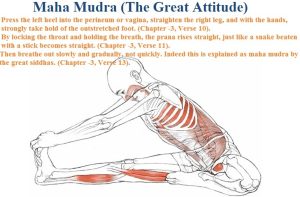Maha Mudra
Introduction
Maha Mudra, described in the Hatha Yoga Pradipika and other classical yoga texts, is one of the most revered yogic practices. Considered a king among mudras, it harmonizes the body, mind, and spirit. Maha Mudra combines asanas, bandhas, pranayama, and drishti (gaze) to awaken prana, stimulate the chakras, and purify the nadis (energy channels). It is said to bestow liberation (moksha) when practiced with devotion and discipline.
Meaning
Maha = Great, supreme.
Mudra = Gesture, seal, psychic attitude.
Thus, Maha Mudra means the great gesture/seal, symbolizing the unification of pranic energy and consciousness.
It represents the harmonization of Ida, Pingala, and Sushumna Nadis, which leads to spiritual awakening.
How to Perform (Practice)
Sit in utthanpadasana with the right leg outstretched. Keep the back straight.
Relax the whole body. Practice khechari mudra. Take a deep breath in.
Exhale and bend forward. Clasp the right big toe with both hands.
Keep the head erect, and the back straight.
Slowly inhale, tilting the head slightly back. Perform shambhavi mudra and then moola bandha.
Hold the breath inside and rotate the awareness from the eyebrow centre, to the throat, to the perineum.
Mentally repeat, ‘ajna, vishuddhi, mooladhara’. The concentration should remain at each chakra for only I or 2 seconds.
Release shambhavi and moola bandha. Slowly exhale, returning to the upright position.
This is one round.
Benefits
Physical Benefits
Stimulates the pancreas, liver, spleen, kidneys, and digestive organs.
Helps regulate insulin and blood sugar (useful in diabetes management).
Improves digestion and metabolism.
Strengthens pelvic floor, spinal muscles, and hamstrings.
Pranic/Energetic Benefits
Purifies the nadis (energy channels).
Balances Ida (lunar), Pingala (solar), and activates Sushumna Nadi.
Directs prana to higher chakras.
Enhances vitality and pranic reserve.
Mental & Spiritual Benefits
Improves concentration and meditative awareness.
Removes lethargy and mental dullness.
Dissolves energetic blockages (granthis).
Leads toward Samadhi (union with higher consciousness).
Contraindications
Avoid in cases of:
Severe back or spinal issues,
Hypertension,
Heart disease,
Hernia, ulcers, colitis,
Pregnancy.
Should not be practiced after meals.
Advanced practice with bandhas and retention should only be done under expert supervision.
Anatomy & Physiology
Involves forward bending → stretches hamstrings, calves, spinal extensors.
Compression of the abdomen massages pancreas and digestive organs.
Bandhas stimulate the endocrine glands:
Mula Bandha → pelvic/urogenital region.
Jalandhara Bandha → thyroid and parathyroid.
Retention of breath increases oxygen utilization and carbon dioxide tolerance.
Kinesiology
Involves hip flexion, spinal flexion, and ankle dorsiflexion.
Engages hamstrings, erector spinae, abdominals, and pelvic floor.
Strengthens and lengthens posterior chain muscles.
Neurology
Breath retention + bandhas stimulate autonomic nervous system regulation.
Jalandhara Bandha influences baroreceptors in the neck, balancing heart rate and BP.
Enhances vagal stimulation (parasympathetic dominance → relaxation).
Focus on Ajna Chakra activates higher brain centers (frontal lobe, pineal gland).
Duration of Practice
Beginners: 1–2 minutes per side, 3–5 rounds.
Intermediate: Up to 5 minutes per side.
Advanced: Integrated with pranayama and mantra, up to 30 minutes.
Best practiced early morning on an empty stomach.
Counter Mudra
To balance Maha Mudra’s intense internal effects:
Shakti Mudra → promotes calmness and cooling.
Chin Mudra → aids grounding and meditation.
Prana Mudra → restores vitality gently.
Conclusion
Maha Mudra is rightly called the great mudra, as it integrates posture, bandhas, pranayama, and concentration. It cleanses the nadis, activates pranic energy, harmonizes endocrine function, and uplifts the practitioner toward higher states of consciousness. While offering immense physical, mental, and spiritual benefits, it should be practiced progressively, with guidance, and avoided by those with contraindicated health conditions.
FAQ
Q1. Can Maha Mudra cure diabetes?
It helps regulate pancreatic function and insulin secretion, making it supportive but not a replacement for medical treatment.
Q2. Is it suitable for beginners?
Yes, in a simplified form without bandhas and retention. Advanced practice requires guidance.
Q3. When should I practice Maha Mudra?
Early morning, on an empty stomach, in a quiet environment.
Q4. Does it awaken Kundalini?
Yes, it purifies the nadis and directs prana into Sushumna, preparing for Kundalini awakening.
Q5. Can women practice it during menstruation?
It is best avoided during menstruation due to bandhas and abdominal pressure.
References
Hatha Yoga Pradipika – Svātmārāma.
Gheranda Samhita.
Swami Satyananda Saraswati – Asana, Pranayama, Mudra, Bandha.
Kuvalayananda – Yoga Mimamsa Journal (scientific research on mudras and bandhas).
Swami Niranjanananda – Prana and Pranayama.

